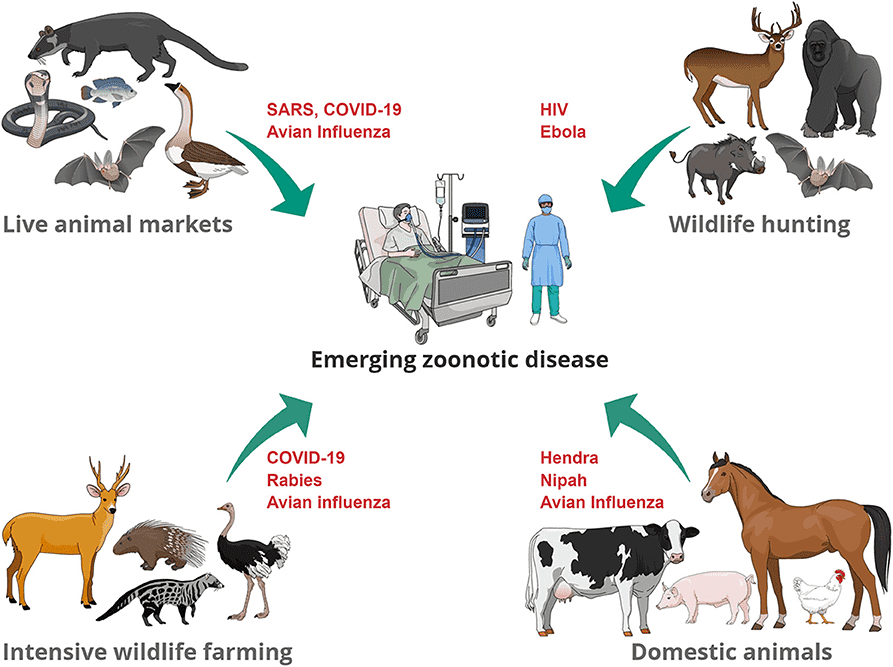Overview of Zoonoses
Zoonoses are considered conventional infections that can be propagated between humans and specific animals, usually caused by microorganisms shared by humans and other vertebrates. These pathogens range widely. In addition to this, these diseases may also involve rare pathogens that can be distributed to humans by means of direct contact or through water, food or the circumstance. It is worth noting that these microbes can cause distinct diseases in organisms, from mild to severe and even death. Furthermore, multiple factors such as urbanization, tourism, climate change and external factors contribute to the appearance of the diseases. Over time, the number of zoonotic diseases has increased. At present, such disorders have emerged as serious public health problems.
 Fig.1 Examples of zoonotic diseases. (Magouras, 2020)
Fig.1 Examples of zoonotic diseases. (Magouras, 2020)
Classification
Such disorders are closely related to multiple microbes. Different pathogens may be involved in different diseases. According to the etiology, these disorders are divided into diverse categories, including diseases caused by normal microorganisms and diseases caused by acellular, nonviral pathogens.
-
Bacterial diseases
Bacterial zoonosis is one of the most prevalent zoonotic diseases in daily life. Such diseases may reappear after they are considered under control. The general infections in humans are spread through the bites and scratches of animals. More importantly, this type of disease spreads very quickly and can be transmitted through direct contact with sick animals. Additionally, either direct or indirect contact with the saliva, blood, feces as well as urine of ill animals can also lead to the spread of these illnesses.
-
Viral zoonoses
It is well known that many organisms such as reptiles, birds as well as mammals, are ordinary hosts of viral pathogens. Typically, some zoonotic viruses possess very limited host ranges. The consequences of such disorders range widely and may range from mild to fatal. Hundreds of viruses are zoonotic, however, multiple of these viruses have not been fully studied.
-
Parasitic zoonosis
Research has shown that many parasitic diseases, such as toxoplasmosis and cryptosporidiosis, are capable of exerting adverse influence on some immunosuppressed patients. Moreover, some parasitic diseases caused by roundworms, helminths, and protozoa are zoonotic.
-
Fungal diseases
Zoonotic fungal infections have long been recognized as a critical public health concern. These illnesses pose a hazard to humans who come into contact with infected animals. What's more, exposure to fungal-contaminated environments is thought to be a key pathway for the natural transmission of these diseases. Several popular fungal diseases include sporotrichosis, histoplasmosis and dermatophytosis.
Major Zoonotic Diseases
| Disease | Etiology | System or Organs Involved |
|---|---|---|
| Anthrax | Bacillus anthracis | Skin and respiratory organs |
| Brucellosis |
Brucella abortus Brucella melitensis |
Back and joint |
| Actinomycosis | Actinomyces bovis | Lymph nodes and skin |
| Rabies | Rabies virus | Nervous system |
| Monkeypox | Monkeypox virus | Skin |
| Epidemic typhus | Rickettsia prowazekii | Headache, myalgia, arthralgias and rashes |
| Psittacosis | Chlamydia psittaci | Throat, myalgias and arthralgias |
| Leishmaniasis | Leishmania infantum | Skin lesions and hepatosplenomegaly |
We provide Abs against various zoonotic disease-related microbial pathogens, including but not limited to those mentioned in the above table. Our diversified Ab will provide a promising tool for your zoonotic disease research. If you are interested in our anti-zoonotic disease Ab products, please feel free to contact us.
Click on the links below to learn more about Ab products:
- Anti-Gut Microbiota Antibody Products
- Anti-Foodborne Pathogen Antibody Products
- Anti-Sexually Transmitted Infection Antibody Products
- Anti-Plant Pathogen Antibody Products
- Fermentation Related Antibody Products
- Magouras, Ioannis, et al. "Emerging zoonotic diseases: Should we rethink the animal–human interface?." Frontiers in veterinary science 7 (2020): 582743. Distributed under Open Access license CC By 4.0, without modification.